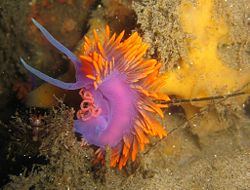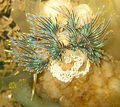Difference between revisions of "Nudibranch" - New World Encyclopedia
Rick Swarts (talk | contribs) |
Rick Swarts (talk | contribs) |
||
| Line 20: | Line 20: | ||
A '''nudibranch''' is any of the soft-bodied, shell-less [[marine (ocean)|marine]] [[gastropod]]s comprising the [[mollusk]] taxon (order or suborder) '''Nudibranchia'''. Found on the bottom of oceans throughout the world, from reefs and sandy shallows to seabeds a mile deep, there are more than 3,000 known species of nudibranchs (Holland 2008). The word "nudibranch," which comes from the [[Latin]] ''nudus'' for "naked," and the [[Greek language|Greek]] ''brankhia'' for [[gill]]s, describes thier feathery gills and horns that many have on their dorsal sides (NGS 2008). Nudibranchs sometimes are called '''sea slugs''', although this term technically applies to a more inclusive taxon of marine gastropod mollusks, Heterobranchia, which includes the nudibranchs. | A '''nudibranch''' is any of the soft-bodied, shell-less [[marine (ocean)|marine]] [[gastropod]]s comprising the [[mollusk]] taxon (order or suborder) '''Nudibranchia'''. Found on the bottom of oceans throughout the world, from reefs and sandy shallows to seabeds a mile deep, there are more than 3,000 known species of nudibranchs (Holland 2008). The word "nudibranch," which comes from the [[Latin]] ''nudus'' for "naked," and the [[Greek language|Greek]] ''brankhia'' for [[gill]]s, describes thier feathery gills and horns that many have on their dorsal sides (NGS 2008). Nudibranchs sometimes are called '''sea slugs''', although this term technically applies to a more inclusive taxon of marine gastropod mollusks, Heterobranchia, which includes the nudibranchs. | ||
| − | Nudibranchs are known for their often extraordinary colors, striking forms, and intricate patterns. Such | + | Nudibranchs are known for their often extraordinary colors, striking forms, and intricate patterns. Such brilliant hues and fascinating shapes have added greatly to the wonder of nature. However, nudibranchs also provide important ecological functions, playing an important role in marine [[food chain]]s, both as predator ([[coral]]s, [[sponge]]s, [[anemone]]s, [[barnacle]]s, [[fish]]) and prey (fish, [[sea spider]]s, [[turtle]]s, [[sea star]]s)—the latter role despite protective mechanisms ranging from poisons, to [[camouflage]], to stinging cells. |
| − | + | Overview and description== | |
Gastropods | Gastropods | ||
Revision as of 23:09, 23 July 2008
| Nudibranch | ||||||||||||||
|---|---|---|---|---|---|---|---|---|---|---|---|---|---|---|
 Spanish shawl, Flabellina iodinea
| ||||||||||||||
| Scientific classification | ||||||||||||||
| ||||||||||||||
See text for superfamilies |
A nudibranch is any of the soft-bodied, shell-less marine gastropods comprising the mollusk taxon (order or suborder) Nudibranchia. Found on the bottom of oceans throughout the world, from reefs and sandy shallows to seabeds a mile deep, there are more than 3,000 known species of nudibranchs (Holland 2008). The word "nudibranch," which comes from the Latin nudus for "naked," and the Greek brankhia for gills, describes thier feathery gills and horns that many have on their dorsal sides (NGS 2008). Nudibranchs sometimes are called sea slugs, although this term technically applies to a more inclusive taxon of marine gastropod mollusks, Heterobranchia, which includes the nudibranchs.
Nudibranchs are known for their often extraordinary colors, striking forms, and intricate patterns. Such brilliant hues and fascinating shapes have added greatly to the wonder of nature. However, nudibranchs also provide important ecological functions, playing an important role in marine food chains, both as predator (corals, sponges, anemones, barnacles, fish) and prey (fish, sea spiders, turtles, sea stars)—the latter role despite protective mechanisms ranging from poisons, to camouflage, to stinging cells.
Overview and description==
Gastropods
Nudibranchs are often casually called "sea slugs", a non-scientific term which has led some people to assume that every sea slug is a nudibranch. However, while it is true that nudibranchs are very numerous in terms of species, and are often very attractive, there are numerous other kinds of sea slugs belonging to several taxonomic groups that are not very closely related to nudibranchs. A fair number of these other sea slugs are colorful and thus are even more easily confused with nudibranchs.
(Other marine shell-less gastropods or "sea slug" groups include additional heterobranch shell-less gastropod groups such as the Cephalaspidea sea slugs including the colorful Aglajidae, and other heterobranchs such as the Sacoglossa, the sea butterflies, the sea angels, and the often rather large sea hares. The term sea slug is also sometimes loosely applied to the only very distantly related, pelagic, caenogastropods within the superfamily Carinarioidea, and may also be casually used for the even more distantly related pulmonate sea slugs, the Onchidiidae.)
Distribution
Nudibranchs occur worldwide.
Habitat
Nudibranchs live at virtually all depths of salt water, but reach their greatest size and variation in warm, shallow waters.
Description
The body forms of nudibranchs vary enormously, but because they are opisthobranchs, unlike most other gastropods they are bilaterally symmetrical because they have undergone secondary detorsion.
They lack a mantle cavity.
They vary in adult size from 20 to 600 mm.
The adult form is without a shell or operculum (a bony or horny plate covering the opening of the shell, when the body is withdrawn).
The name nudibranch is appropriate, since the dorids (infraclass Anthobranchia) breathe through a branchial plume of bushy extremities on their back, rather than using gills. By contrast, on the back of the aeolids in infraclass Cladobranchia there are brightly colored sets of tentacles called cerata.
Nudibranchs have cephalic (head) tentacles, which are sensitive to touch, taste, and smell. Club-shaped rhinophores detect odors.
Life habits
Reproduction
Nudibranchs are hermaphroditic, and thus have a set of reproductive organs for both genders, but they can rarely fertilize themselves.
Nudibranchs typically deposit their eggs within a gelatinous spiral. [1]
Feeding
Nudibranchs are carnivorous. Some feed on sponges, others on hydroids, others on bryozoans, and some are cannibals, eating other sea slugs, or, on some occasions, members of their own species. There is also a group that feeds on tunicates and barnacles. They even sometimes feed on anemones.
Colors and camouflage
Among this group can be found the most colorful creatures on earth. In the course of evolution, sea slugs have lost their shell because they have developed other defense mechanisms. Their anatomy may resemble the texture and color of the surrounding plants, allowing them to camouflage (cryptic behavior). Others, as seen especially well on Chromodorids, have an intense and bright coloring, which warns that they are distasteful or poisonous (aposematic coloration).
Nudibranchs that feed on hydroids can store the hydroid's nematocysts (stinging cells) in the dorsal body wall, the cerata.[2] The nematocysts wander through the alimentary tract without harming the nudibranch. Once further into the organ, the cells are brought to the specific placements on the creature's hind body via intestinal protuberances. Nudibranches can protect themselves from the hydroids and their nematocysts. It is not yet clear how, but special cells with large vacuoles probably play an important role. They can also take in plants' chloroplasts (plant cell organelles used for photosynthesis) and use them to make food for themselves.
Another way of protection is the release of a sour liquid from the skin. Once the specimen is physically irritated or touched by another creature, it will release the slime automatically.
Taxonomy

The taxonomy of the Nudibranchia is still under investigation. Many taxonomists in the past treated the Nudibranchia as an order, based on the authoritative work of Johannes Thiele (1931), who built on the concepts of Henri Milne-Edwards (1848). Newer insights derived from morphological data and gene-sequence research, have confirmed these ideas. On the basis of investigation of 18S rDNA sequence data, there is strong evidence for support of the monophyly of the Nudibranchia and its two major groups, the Anthobranchia/Doridoidea and Cladobranchia.
- Infraorder Anthobranchia Férussac, 1819 (dorids)
- Superfamily Doridoidea Rafinesque, 1815
- Superfamily Doridoxoidea Bergh, 1900
- Superfamily Onchidoridoidea Alder & Hancock, 1845
- Superfamily Polyceroidea Alder & Hancock, 1845
- Infraorder Cladobranchia Willan & Morton, 1984 (aeolids)
- Superfamily Aeolidioidea J. E. Gray, 1827
- Superfamily Arminoidea Rafinesque, 1814
- Superfamily Dendronotoidea Allman, 1845
- Superfamily Metarminoidea Odhner in Franc, 1968
A study published in May 2001, has again revised the taxonomy of the Nudibranchia [3]. They are thus divided into two major clades:
- Anthobranchia (= Bathydoridoidea + Doridoidea)
- Dexiarchia nom. nov. (= Doridoxoidea + Dendronotoidea + Aeolidoidea + “Arminoidea”).
The dorids (infraorder Anthobranchia) have the following characteristics: the branchial plume forms a cluster on the posterior part of the neck, around the eyes. Fringes on the mantle do not contain any intestines.
The aeolids (infraorder Cladobranchia) have the following characteristics: Instead of the branchial plume, they have cerata. They lack a mantle. Only species of the Cladobranchia are reported to house zooxanthellae.
Images
Red nudibranch
Hurghada, EgyptPyjamas nudibranch
Hurghada, EgyptHypselodoris bullocki
Sipadan, MalaysiaNembrotha chamberlaini
Sipadan, MalaysiaCollingwood's chromodoris
Papua New GuineaChromodoris lochi
Papua New GuineaTwo clown nudibranchs
New ZealandNotodoris minor on the ribbon reefs off Cooktown, Queensland, Australia
Chromodoris willani
Lembeh Straits, IndonesiaNembrotha kubaryana
Lembeh Straits, IndonesiaChromodoris annae
Lembeh Straits, IndonesiaPteraeolidia ianthina
Lembeh Straits, IndonesiaClown nudibranch
Triopha catalinae, Northern CaliforniaAcanthodoris lutea
Northern California
Footnotes
- ↑ Klussmann-Kolb A (2001). The Reproductive Systems of the Nudibranchia (Gastropoda, Opisthobranchia): Comparative Histology and Ultrastructure of the Nidamental Glands with Aspects of Functional Morphology. Zoologischer Anzeiger 240 (2): 119–136.
- ↑ Frick, K (2003). Predator Suites and Flabellinid Nudibranch Nematocyst Complements in the Gulf of Maine.. In: SF Norton (ed). Diving for Science...2003. Proceedings of the American Academy of Underwater Sciences (22nd Annual Scientific Diving Symposium).
- ↑ Schrödl M.; Wägele H.2 Willan R.C. (2001). Taxonomic Redescription of the Doridoxidae(Gastropoda: Opisthobranchia), an Enigmatic Family of Deep Water Nudibranchs, with Discussion of Basal Nudibranch Phylogeny. Zoologischer Anzeiger, 240 (1): 83.
ReferencesISBN links support NWE through referral fees
- H. Wägele and R. C. Willan (September 2000). Phylogeny of the Nudibranchia. Zoological Journal of the Linnean Society 1 (1): 83–181.
National Geographic Society. 2008. Nudibranch (Nudibranchia).
Holland, J. S. 2008. Living color: Toxic nudibranchs—soft, seagoing slugs—produce a brilliant defense. National Geographic June 2008. Retrieved July 23, 2008.
- Integrated Taxonomic Information System (ITIS). 2004. Nudibranchia Blainville, 1814 ITIS Taxonomic Serial No.: 78156. Retrieved July 23, 2008.
External links
- Lots of images and information on Australian nudibranchs
- Nudibranchs in their natural environment, Scuba Diving - Narooma NSW
- Sea Slug Forum: many images and much valuable information worldwide
- Nudi Pixel: Online resource for nudibranchs and sea slugs identification using photographs
- Nudibranch gallery
- Bibliography and portal to opisthobranch, nudibranch & seaslug information
- Nudibranch photo gallery from Bali
- Scottish Nudibranchs: Online resource for identification of species found in Scottish waters
- Born to be Wild: Sea Slugs, 04/30/2008
- http://ngm.nationalgeographic.com/2008/06/nudibranchs/doubilet-photography?email=focus_20080523
Credits
New World Encyclopedia writers and editors rewrote and completed the Wikipedia article in accordance with New World Encyclopedia standards. This article abides by terms of the Creative Commons CC-by-sa 3.0 License (CC-by-sa), which may be used and disseminated with proper attribution. Credit is due under the terms of this license that can reference both the New World Encyclopedia contributors and the selfless volunteer contributors of the Wikimedia Foundation. To cite this article click here for a list of acceptable citing formats.The history of earlier contributions by wikipedians is accessible to researchers here:
The history of this article since it was imported to New World Encyclopedia:
Note: Some restrictions may apply to use of individual images which are separately licensed.

















